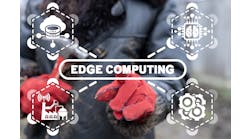A silver lining within COVID...newfound edge capabilities
Already faced with the challenges of reduced staffs and slashed budgets due to COVID-19, industrial companies are faced with redesigning day-to-day operations under ever-changing government guidelines. And as the pandemic becomes more manageable, business owners must determine the best strategies to bring their employees back to work safely and effectively.
Edge computing can help while delivering actual newfound benefits.
Here we chat with Duncan Cooke, business development executive at Stratus Technologies, about cost-effective ways to implement edge computing to manage devices efficiently during these turbulent times.
Take a look…
Smart Industry: What kind of data can be collected from new safety measures related to the pandemic?
Duncan: There is an abundance of “new” data that is now being presented. New edge-connected devices, such as thermal cameras, are being deployed for heath-checking purposes, generating personnel-temperature profiles. Existing devices are also being explored for more data; metadata streams from video-analytic devices, for example, are being examined in more detail to see what meaningful additional data can be extracted.
Smart Industry: How can this data be used? How does it differ from traditional industrial-workplace data?
Duncan: Traditional workplace data, particularly with access-control systems, is often presented and utilized rather simplistically; who went where and when. Broader metadata from video-analytic-capable cameras, for example, have the ability to generate metadata that is now being used proactively to generate people counts, tracking information, occupancy density and, generally, applied to assist with social-distancing compliance. Linked to database sources, such as HR and/or payroll, powerful insights into personnel activities and movements can result.
Smart Industry: What types of new technologies are we talking about here?
Duncan: Some of the technologies being used are not necessarily new; rather they are being deployed in different scenarios. Thermal devices are now being pitched as heath-checking systems, collecting and comparing temperature profiles. Video-analytic devices, either edge-enabled or edge-connected, are being used to their full extent with the resultant metadata being mined to produce tracking and mapping data that was always available but often overlooked or discarded.
Smart Industry: How does edge computing enable proper management of these tools and techniques?
Duncan: More data at the edge creates a greater demand for associated compute solutions. Enterprise infrastructures can be expensive to reprovision and/or expand to accommodate this increased data flow. Edge computing is the simple, secure and autonomous solution, allowing for rapid data acquisition and processing, securely, in-situ and often without the need for specialist resources to deploy.
Smart Industry: How can organizations manage this data?
Duncan: Utilizing resilient edge-compute solutions ensures data is actioned and maintained at source. Data which, in the past, has either been ignored or discarded can now be selectively managed and presented in a meaningful manner without the need to route and process it within the wider enterprise environment or the cloud, thus negating the associated security risks such data movement presents.
Smart Industry: What do you see as a positive outcome from this challenging COVID era?
Duncan: Despite the unfortunate reality of the reduction in frontline personnel, compounded by the inevitable changes in working practices associated with the implementation of new policies, we are witnessing safer working conditions and a greater appreciation of what can be achieved at the edge. Whether that be adding new devices or fully utilizing existing ones, combined with an awareness of what can be achieved using simple, secure and autonomous edge-compute solutions. There’s a very strong case to support “doing more with less.”


